Curio talinoides
Curio talinoides (DC.) P.V.Heath
Family: Asteraceae
Common names: blue straws (Eng.); dassieharpuis (Afr.)
Introduction
A conspicuous, spreading, succulent shrub with striking, bluish grey-green, elongated, rounded, succulent leaves, with a resinous smell when damaged. The flowers are inconspicuous, produced in corymbs at the branch ends in late spring and early summer. Known from the Eastern Cape of South Africa, growing mainly on cliffs and confined to deep rocky gorges. Easily grown from cuttings and best for dry, warm gardens.
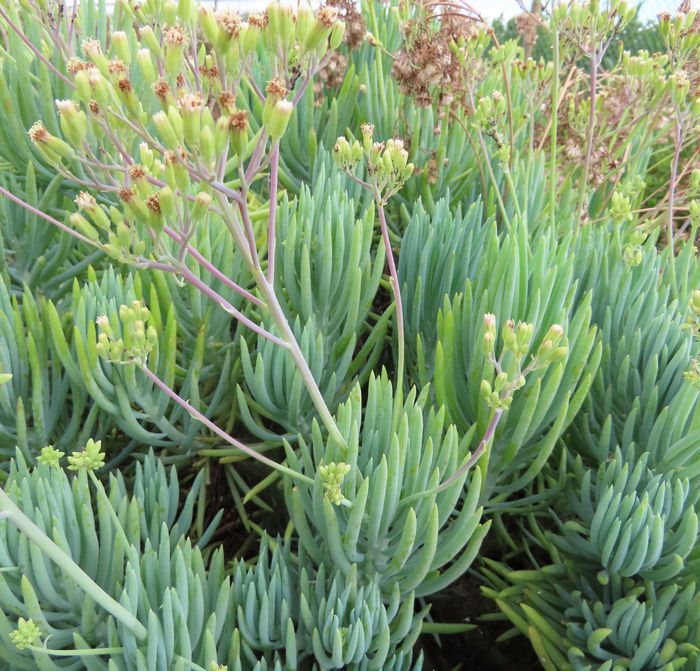
Description
Description
Curio talinoides is an ascending, much-branched, evergreen, shrubby succulent, about 500 to 700 mm tall and to about 800 mm in diameter, rooting where the branches touch the ground. Roots are fibrous. Branches are brittle, rounded, succulent, woody below, easily broken and with a resinous scent. Main branch about 20 mm in diameter, glaucous, blue-green. Leaves and stems pruinose, thickly covered with a powdery white bloom, resulting in their attractive bluish to bluish grey-green colour. The leaves are densely and alternately arranged, crowded on the stems, set about 3-5 mm apart, linear, ascending, falcate (sickle shaped), tapering at both ends, about 45-95 mm long, rounded (terete) to slightly flattened laterally, 4-6 mm thick, and obscurely striated lengthwise, ending in a stiff sharp point.
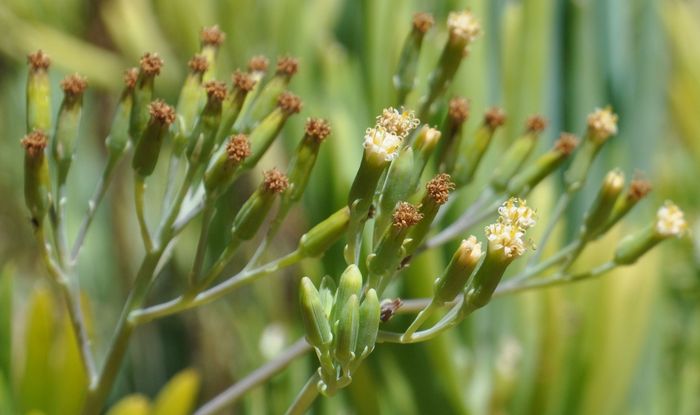
The inflorescence is produced at the ends of the branches, 150-240 mm long, a sub-corymb, the branching v-shaped, the inflorescence stalk slender, terete 2-3 mm in diameter, the bracts narrow up to 14 mm long at the base, becoming smaller upwards (5-6 mm).
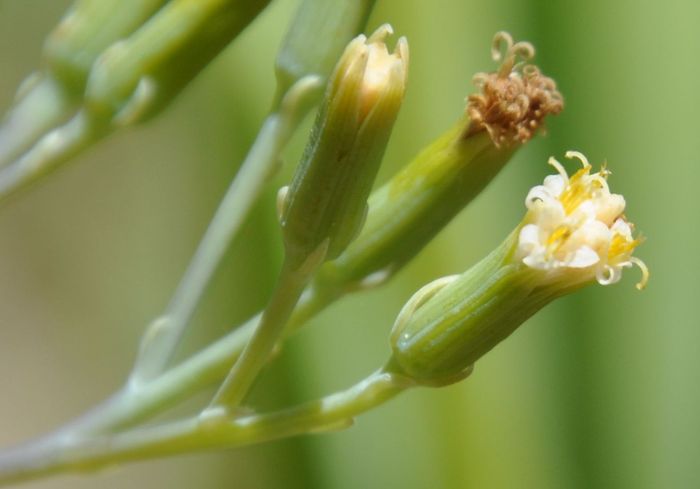
The capitula (composite flowerheads), about 30-40 per inflorescence, each 8 mm long and 3,5 mm in diameter, rounded at the top in full flower, ray florets absent, disc florets white, about 8 per capitulum, the corolla lobes recurved, style and stigmas protruding 2 mm. Seed oblong 4 x 0,5 mm.
Flowering time is mainly in late spring to early summer (October-November) but flowers may be present at any time of the year.
Conservation Status
Status
Plants are locally abundant, usually in habitats that are difficult to reach. This species is widespread, well established in cultivation and the nursery trade and consequently not threatened.
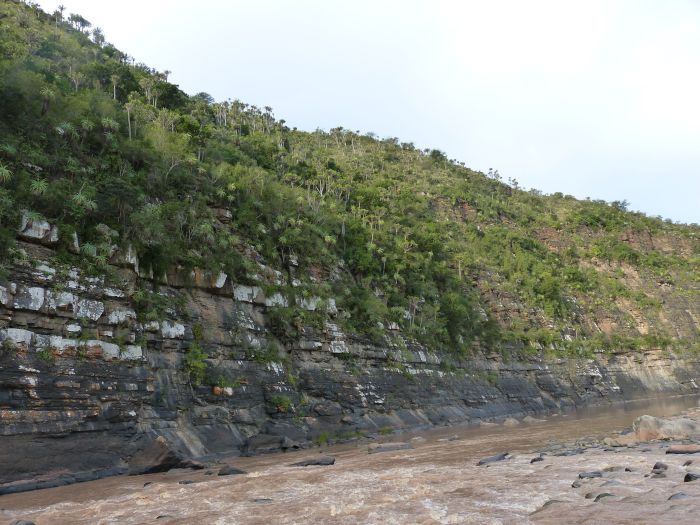
Distribution and habitat
Distribution description
Curio talinoides is known from cliffs along the dry river valleys of the Eastern Cape, from the Keiskamma River in the south to the Msikaba River in the north. The main habitat is steep exposed rocky slopes in Albany Thicket vegetation (Albany Thicket Biome) and Eastern Valley Bushveld (Savanna Biome). The geology consists mainly of Ecca shale (Karoo Formation).
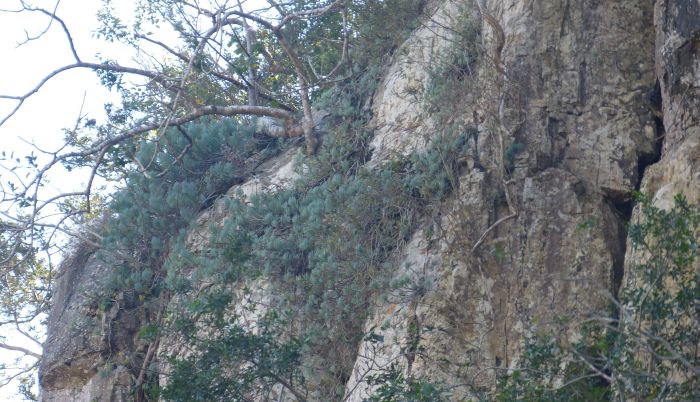
Derivation of name and historical aspects
History
The plant was first named Kleinia talinoides by the Swiss botanist and naturalist Augustus Pyramus de Candolle (1778—1841) in his Prodromus in 1838. The species name talinoides pertains to its likeness to the genus Talinum of the family Talinaceae, formerly Portulacaceae. Paul Heath in the journal Calyx transferred this species to his new genus Curio in 1999.
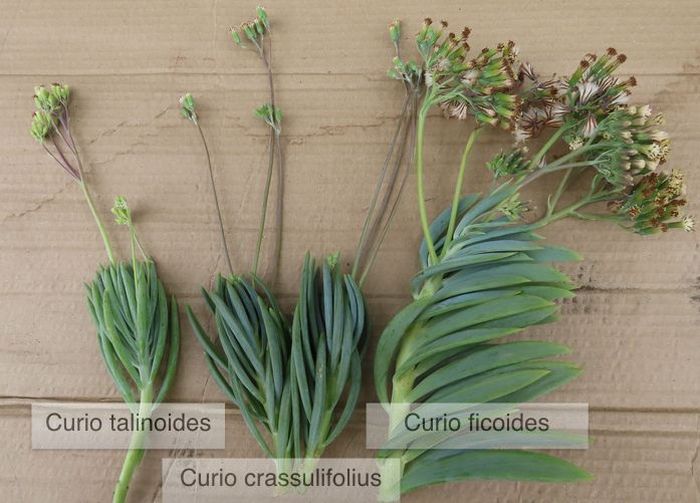
Curio talinoides is sometimes confused with the two related species Curio ficoides and C. crassulifolius, both having been written up in PlantZAfrica. However, it is easily distinguished at once by its numerous, densely arranged, linear, falcate, rounded (terete) leaves. Curio ficoides has robust, flattened, much thicker leaves that are not densely arranged as in C. talinoides. It is somewhat similar to C. crassulifolius but the latter has shorter leaves and much larger flowers.
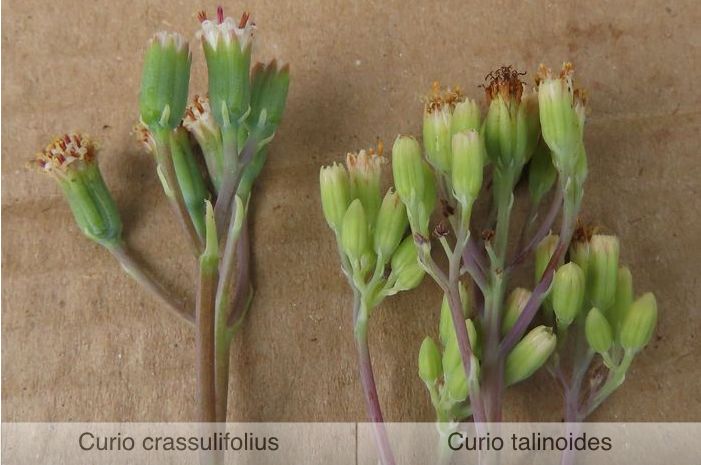
Curio talinoides is the second largest, of about 20 known species of Curio, confined to South Africa.
Synonyms: Senecio talinoides (DC.) Sch.Bip., Kleinia cylindrica A.Berger, Kleinia spiculosa Shepherd, Kleinia talinoides subsp. cylindricus (Bgr.) G.D.Rowley, Senecio cylindricus (A.Berger) Jacobsen, Senecio spiculosus (Shepherd) Rowley, Senecio talinoides subsp. cylindricus (A.Berger) G.D.Rowley, Senecio vitalis N.E.Brown.
Ecology
Ecology
Curio talinoides grows on exposed, sheer cliff faces, often on the shady south-facing slopes, the reclining stems sometimes rooting and forming new groups. The powdery bloom and bluish grey colour on the leaves and stems reflects the harsh sun and acts as a sun screen. The succulent nature enables the plant to survive periods of drought, when the leaves become very thin, only to revive after a rain shower.

At the Keiskamma River (south of East London), Curio talinoides grows on exposed slopes in Buffalo Thicket vegetation, rich in succulent plants. Associated species include Tetradenia barberae, Crassula perforata, Crassula rupestris, C. pellucida subsp. marginalis, Crassula cultrata and C. rupestris, Aloe pluridens and A. speciosa, Delosperma tradescantioides, Ficus burtt-davyi, Cotyledon velutina, , Bulbine latifolia, Haworthia cymbiformis var. ramosa, Pelargonium inquinans, Portulacaria afra and Senecio voigtii.
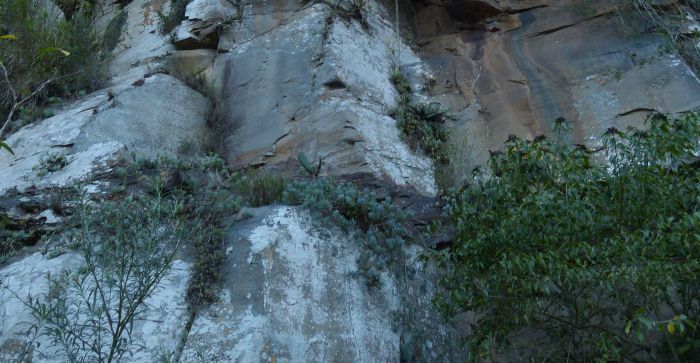
Along the Mtata River north of East London in the Eastern Cape, plants was found on sheer cliffs adjacent to the river growing mainly on south-facing slopes. The vegetation here consists of Eastern Valley Bushveld with plants such as Gasteria excelsa, Haworthia cymbiformis var. setulifera, Cotyledon petiolare, Euphorbia triangularis, Adromischus sphenophyllus, Crassula lactea, C. ovata and C. perforata, Aloe speciosa and Portulacaria afra.
The average annual rainfall in its habitat varies from 400-600 mm per annum and it is at an altitude of 200-800 m above sea level. Precipitation occurs mainly in the form of thunder showers in summer and to a lesser extent cold fronts during winter. In its natural habitat the stems often recline and are well-adapted to the steep slopes and cliffs where the plants grow.
The plants vary in leaf size, shape and colour. The most striking is are the crowded blue- to grey-green, rounded, sickle-shaped leaves.
The cliff face is an ideal refuge, protecting the plants from larger herbivores. As with many associated succulents, branches which become detached fall onto ledges and will root spontaneously when favourable conditions prevail.
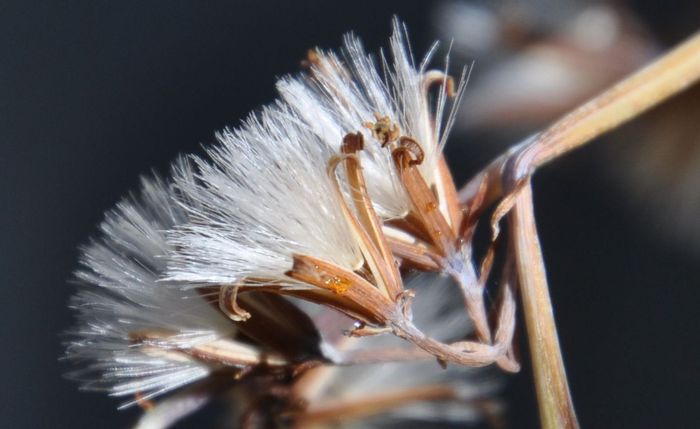
The downy seeds are dispersed by wind, and with favourable conditions seeds will germinate in suitable crevices.
Uses
Use
It is not known whether the plants are used medicinally. This species has proven to be an easy-to-grow, drought-tolerant and rewarding ornamental garden plant and pot plant.
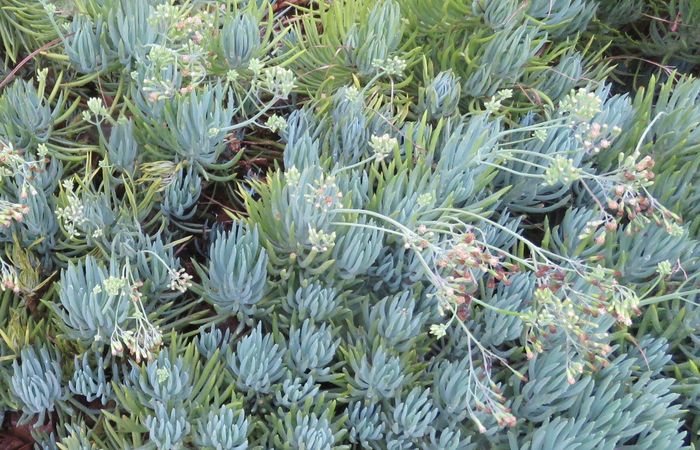
Growing Curio talinoides
Grow
Curio talinoides is well established in the horticultural trade in Mediterranean-type climates of the world. This is because of its tolerance for hot, dry weather, ease of growth and striking crowded bluish, grey-green leaves. It is well suited to dry gardens where frost is not too severe. It grows well in dry Mediterranean gardens. It requires a warm, sunny, well-drained position. Best planted in rockeries or steep embankments. It is especially attractive among cycads and other succulent plants. In South Africa it is best grown in thicket and succulent Karoo gardens (Van Jaarsveld 2010) or in dry fynbos gardens. Plants planted out of doors at Babylonstoren (which is in a winter rainfall area) have grown very successfully. Curio talinoides will tolerate a wide range of soils and grows well in seafront and coastal gardens. It is also easily grown in containers.
Plants are easily propagated by stem cuttings, preferably taken in spring or summer. The cuttings can either be rooted first in sand and transplanted, or planted directly into the required position, but, for successful establishment, they should be kept moist. Curio talinoides plants are relatively fast growing and will soon form shrublets.
References
- Clarke, H. & Charters, M. 2016. The illustrated dictionary of southern African plant names. Flora & Fauna Publications Trust, Jacana, Johannesburg.
- De Candolle, DC. 1838. Kleinia talinoides in Prodromus Systematis Naturalis Regni Vegetabilis, 6: 337.
- Eggli, U. (ed). 2001. Illustrated handbook of succulent plants: Dicotyledons. Springer, Berlin Heidelberg.
- Heath, P.V. 1999. Three new generic names in the Asteraceae (part 2). Calyx 6(2): 54-55.
- Harvey, W.H. 1894. Compositae. In: W.H. Harvey and O.W. Sonder (eds). Flora Capensis III (Rubiaceae to Campanulaceae):44-530. L. Reeve & Co., Ltd., Ashford.
- Mucina, L. & Rutherford, M.C. (eds) 2006. The vegetation of South Africa, Lesotho and Swaziland. Strelitzia 19. South African National Biodiversity Institute, Pretoria.
- Rowley, G.D. 1994. Succulent compositae. A grower’s guide to the succulent species of Senecio & Othonna. Strawberry Press, California.
- Van Jaarsveld, E.J. 2010. Water wise gardening. Struik, Cape Town.
Credits
Ernst van Jaarsveld
Kirstenbosch National Botanical Garden (Retired 2015)
Babylonstoren Farm
Extraordinary senior lecturer and researcher,
Department of Biodiversity and Conservation, University of the Western Cape
December 2019
Plant Attributes:
Plant Type: Ground Cover, Succulent
SA Distribution: Eastern Cape
Soil type: Sandy, Loam
Flowering season: Early Summer
PH: Acid, Neutral
Flower colour: Green, White, Yellow
Aspect: Full Sun, Morning Sun (Semi Shade), Afternoon Sun (Semi Shade)
Gardening skill: Easy
Special Features:
Horticultural zones










Rate this article
Article well written and informative
Rate this plant
Is this an interesting plant?
Login to add your Comment
Back to topNot registered yet? Click here to register.